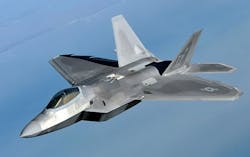Lockheed Martin to upgrade communications avionics in Air Force fleet of F-22 jet fighters
Officials of the Air Force Life Cycle Management Center at Hill Air Force Base, Utah, are asking the Lockheed Martin Aeronautics segment in Fort Worth, Texas, to upgrade the Integrated Communications Navigation and Identification-Friend-or-Foe Avionics (ICNIA) systems in the F-22 fleet.
Lockheed Martin, the F-22 systems integrator, will provide 479 ICNIA retrofit kits and perform 443 installations that will increase reliability of transistors on the CNI Driver B units, Air Force officials say. The Northrop Grumman Aerospace Systems segment in San Diego (formerly TRW Inc.) is the original designer of the F-22's ICNIA system.
The F-22's ICNIA system is a collection of communication, navigation, and identification-friend-or-foe functions that uses the F-22's Raytheon Common Integrated Processor (CIP) for signal and data processing. Each communications navigation identification (CNI) function has its own aperture installed throughout the aircraft.
The CIP, designed originally by Hughes Electronics, is the brain of the F-22's avionics system. It supports all signal and data processing for all of the F-22's onboard sensors and mission avionics. Raytheon acquired Hughes Electronics in 1997.
Related: F-22 avionics designers rely on obsolescent electronics, but plan for future upgrades
Northrop Grumman's ICNIA system provides 14 critical functions, including advanced multichannel and multiband voice and data links, as well as flight navigation and friend-or-foe identification. The system uses software-defined radios to enable simultaneous support of several capabilities for the advanced fighter while reducing pilot workload and minimizing size, weight and power (SWaP) requirements.
story continues below
The Northrop Grumman ICNIA system for the F-22 has about 70 suppliers in 22 states, company officials say. F-22 CNI production, integration, test, and modernization activities are at Northrop Grumman facilities in San Diego.
Aiding the ICNIA system and other F-22 on-board systems are two CIPs in each aircraft, with 66 module slots per CIP. They have identical backplanes, and all of the F-22's processing requirements can be handled by only seven different types of processors. Currently, 19 of 66 slots in CIP 1 and 22 of 66 slots in CIP 2 are not in use and can be used for future growth.
Each module is limited to 75 percent of its capability to give the F-22 30 percent growth capability with no change to the existing equipment. Each aircraft has space power, and cooling for a third CIP.
Related: Could late-model Swedish-made jet fighter be a solution to expensive F-35 and F-22 jets?
Each CIP also contains mission software that uses tailorable mission planning data for sensor emitter management and multisensor fusion. The Raptor's combination of stealth, integrated avionics, maneuverability and supercruise at 1.5 times the speed of sound without afterburner. The plane has first-look, first-shot, first-kill capability against potential enemy aircraft and surface-to-air missiles.
Lockheed Martin built the F-22, a stealthy air-superiority jet fighter, between 1996 and 2011. The company built a total of 195 F-22 aircraft -- eight test planes and 187 operational jet fighters.
The Air Force and Air National Guard base F-22s at Langley Air Force Base, Va.; Eglin Air Force Base, Fla.; Nellis Air Force Base, Nev.; Tyndall air Force Base, Fla.; Edwards Air Force Base, Calif.; Elmendorf Air Force Base, Alaska; and Hickam Air Force Base, Hawaii.
On this contract modification Lockheed Martin will do the work in Clifton, N.J., and should be finished by December 2017. For more information contact Lockheed Martin Aeronautics online at www.lockheedmartin.com/us/aeronautics, or the Air Force Life Cycle Management Center at www.wpafb.af.mil/aflcmc.
